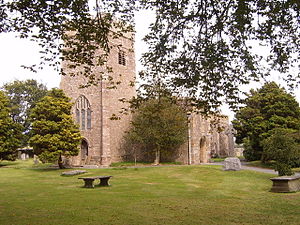- St John the Baptist's Church, Tunstall
-
St John the Baptist's Church,
Tunstall
St John the Baptist's Church, Tunstall,
from the southwestCoordinates: 54°09′35″N 2°35′32″W / 54.1597°N 2.5923°W OS grid reference SD 614 739 Location Tunstall, Lancashire Country England Denomination Anglican History Dedication John the Baptist Significant associated people Sir Thomas Tunstal
Brontë sistersArchitecture Status Parish church Functional status Active Heritage designation Grade I Designated 4 October 1967 Architectural type Church Style Gothic Specifications Capacity 250 Materials Sandstone rubble, slate roof Administration Parish Tunstall, St John the Baptist, Melling, St Wilfrid,
and Leck, St PeterDeanery Tunstall Archdeaconry Lancaster Diocese Blackburn Province York Clergy Vicar(s) Canon Roger N. Hamblin St John the Baptist's Church, Tunstall is located to the northeast of the village of Tunstall, Lancashire, England. It is an active Anglican parish church in the united benefice of East Lonsdale, in the deanery of Tunstall, the archdeaconry of Lancaster and the diocese of Blackburn. The benefice of East Lonsdale combines this church with St Peter, Leck, St Wilfrid, Melling, St James the Less, Tatham, The Good Shepherd, Lowgill, and Holy Trinity, Wray.[1] The church has has been designated by English Heritage as a Grade I listed building[2]
Contents
History
A church at Tunstall is recorded in the Domesday survey but the oldest structure in the present church dates from the 13th century.[3] The church was rebuilt around 1415 by Sir Thomas Tunstal.[4] Alterations were made in the 16th century and the church was restored in 1907. In the 1820s the church was attended by the Brontë sisters during the time they were receiving education at the Clergy Daughters' School at nearby Cowan Bridge.[2]
Architecture
Exterior
The church is built in sandstone rubble with a slate roof. Its plan consists of a west tower, a nave and chancel under a continuous roof, north and south aisles, and a two-storey south porch. The tower has diagonal buttresses and an embattled parapet. Above each of the small bell openings is a carved tablet of an angel holding a shield. The west door has a pointed head above which is a three-light window with Perpendicular tracery. The aisles have embattled parapets, as does the porch. Above the door of the porch is a niche with a sundial plate and above that a small one-light window.[2]
Interior
Internally the responds of the north arcade have early 13th-century capitals and the west lancet windows of the north aisle are probably also from this century.[4] Dating from the 1907 restoration are the roof[2] and the chancel screen.[3] A Roman votive stone has been built into the surround of a window in the north aisle. At the east end of the south aisle is a chapel known as the Chapel of the Holy Trinity. In the chapel is a mutilated effigy which is said to be of Sir Thomas Tunstal.[3] Under the tower arch is an 18th-century oval marble font on sandstone baluster base.[2] The east window contains glass from the Netherlands dating from the late 15th and the 16th centuries.[4] It was donated to the church in 1810 by Richard Toulmin North of nearby Thurland Castle. In the south wall is stained glass dated 1979 by Jane Gray.[3] In the church are a number of memorials to the Fenwick family.[2] The two-manual organ was built in 1923 by Harrison and Harrison.[5]
External features
Near the church is a sandstone sundial base dating probably from the 18th century consisting of a round column with a square cap on a base of three octagonal steps. It is listed Grade II.[6]
References
- ^ Tunstall, St John the Baptist, Church of England, http://www.achurchnearyou.com/tunstall-st-john-the-baptist/, retrieved 28 October 2009
- ^ a b c d e f Church of St John the Baptist, Tunstall (1071642). National Heritage List for England. English Heritage. Retrieved 8 October 2011.
- ^ a b c d Lancashire Churches: Tunstall St John the Baptist, Tony Boughen, http://www.lancashirechurches.co.uk/tunstall.htm, retrieved 1 May 2008
- ^ a b c Pevsner, Nikolaus (2002) [1969], The Buildings of England: North Lancashire, New Haven & London: Yale University Press, pp. 248–249, ISBN 0 300 09617 8
- ^ Tunstall St. John the Baptist, British Institute of Organ Studies, http://www.npor.org.uk/cgi-bin/Rsearch.cgi?Fn=Rsearch&rec_index=G00227, retrieved 13 August 2008
- ^ Sundial base south of Church of St John the Baptist, Tunstall (1165259). National Heritage List for England. English Heritage. Retrieved 8 October 2011.
External links
Categories:- Church of England churches in Lancashire
- Grade I listed churches
- Grade I listed buildings in Lancashire
- English Gothic architecture
- 1410s architecture
- Buildings and structures in Lancaster
- Austin and Paley buildings
Wikimedia Foundation. 2010.
